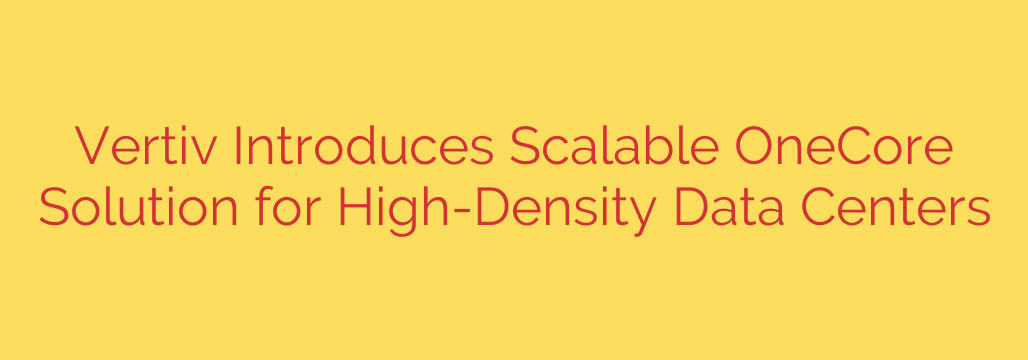
Powering the AI Revolution: A New Era for High-Density Data Center Infrastructure
The rapid rise of Artificial Intelligence (AI) and high-performance computing (HPC) is pushing data center infrastructure to its absolute limit. The days of standard server racks and simple air cooling are quickly fading. Today’s demanding workloads require a new level of power, cooling, and management—one that traditional, piecemeal solutions can no longer provide.
To meet this challenge, a new, holistic approach to data center design is emerging. This strategy moves away from juggling multiple vendors and complex integrations, focusing instead on a unified, scalable system designed from the ground up to handle extreme power and heat densities.
The Core Challenge: Managing Power and Heat in a High-Density World
Modern AI and HPC clusters generate an unprecedented amount of heat in a very concentrated space. This creates a dual problem for data center operators: delivering massive amounts of stable, uninterrupted power and efficiently removing the intense thermal load.
Attempting to solve this with separate, uncoordinated systems for power, cooling, and monitoring often leads to inefficiencies, increased risk of downtime, and a higher total cost of ownership (TCO). The complexity of managing these disparate components can slow down deployment and create operational blind spots.
A more effective strategy involves an integrated ecosystem where every component is designed to work in harmony. This approach provides a streamlined, reliable, and scalable foundation for the data centers of tomorrow.
The Components of a Unified Data Center Solution
A truly integrated system for high-density environments is more than just a collection of products; it’s a comprehensive architecture. The core pillars of this modern infrastructure include:
Advanced Power Management: This begins with high-capacity uninterruptible power supply (UPS) systems and switchgear designed to deliver clean, consistent power without fail. For high-density racks, this means robust power distribution that can handle the extreme electrical demands of next-generation processors and GPUs.
Next-Generation Thermal Management: Traditional air cooling is insufficient for the heat produced by AI workloads. The solution lies in advanced liquid cooling technologies, including direct-to-chip cooling and rear-door heat exchangers. These systems are far more efficient at capturing and removing heat directly at the source, ensuring thermal stability and protecting sensitive hardware.
Centralized Monitoring and Control: You can’t manage what you can’t see. A critical component is a unified monitoring platform that provides a single pane of glass for the entire infrastructure. This allows operators to see real-time data on power consumption, thermal performance, and equipment status, enabling proactive maintenance and preventing issues before they cause downtime.
Intelligent Racks and Enclosures: The physical housing is just as important. Modern rack systems are designed to support the weight and cabling density of high-performance equipment while being optimized for liquid cooling and efficient power distribution.
Key Benefits of an Integrated Infrastructure Approach
Adopting a single, comprehensive solution for your high-density needs delivers powerful advantages that directly impact your bottom line and operational resilience.
Faster Deployment and Time-to-Market: By using a pre-engineered and validated system from a single source, you eliminate the complex and time-consuming process of integrating components from multiple vendors. This significantly accelerates the timeline from design to deployment.
Enhanced Reliability and Uptime: When all components—from the UPS to the liquid cooling loop—are designed to work together, the entire system is more robust. Integrated monitoring and control provide early warnings of potential failures, allowing for preventative action that safeguards uptime.
Future-Proof Scalability: Business needs change, and your data center should be able to adapt. A scalable, modular design allows you to start with the capacity you need today and seamlessly expand as your computing demands grow, protecting your initial investment.
Optimized Total Cost of Ownership (TCO): High-efficiency power and cooling systems directly reduce energy consumption and operational expenses. Furthermore, a simplified, unified management system lowers administrative overhead and reduces the risk of costly, human-error-induced outages.
Actionable Tips for Upgrading Your Data Center
As you plan for a high-density future, keep these practical steps in mind:
Conduct a Thorough Audit: Before investing in new hardware, perform a comprehensive power and cooling audit of your existing facility. Understand your current limitations and project your future density requirements to make an informed decision.
Prioritize Integrated Monitoring: Choose solutions that offer a unified monitoring platform. The ability to correlate data from your power and thermal systems is essential for identifying trends, optimizing efficiency, and preventing downtime.
Think Holistically, Not Incrementally: Avoid the temptation to upgrade one component at a time. A holistic, system-level approach ensures all parts of your infrastructure are matched in capability, preventing performance bottlenecks and compatibility issues down the road.
The era of AI is here, and it demands a smarter, more resilient data center foundation. By embracing integrated, scalable infrastructure solutions, organizations can build the powerful and efficient data centers needed to drive innovation for years to come.
Source: https://datacenternews.asia/story/vertiv-launches-scalable-onecore-solution-for-high-density-data-centres








